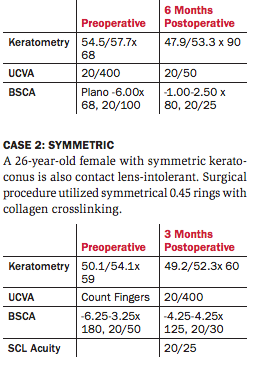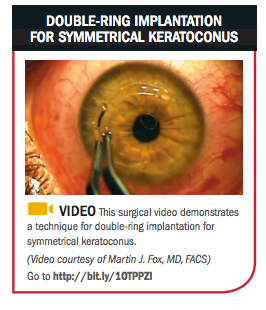Article
Intrastromal rings for keratoconus
Author(s):
Take-home message: Implantation of intrastromal rings for keratoconus can be a highly effective treatment with proper patient screening, surgical planning, and femtosecond laser precision.
Take-home message: Implantation of intrastromal rings for keratoconus can be a highly effective treatment with proper patient screening, surgical planning, and femtosecond laser precision.
By Martin J. Fox, MD, FACS; Special to Ophthalmology Times
Though patients with fully expressed keratoconus often require keratoplasty as the only viable option for visual rehabilitation, precision implantation of intrastromal corneal rings (Intacs, Addition Technology/Oasis) may be offered to carefully selected candidates.
The degenerative disease is characterized by a progressive thinning of the cornea leading to loss of structural integrity and shape distortion. Current estimates suggest that the disease has an incidence of 1 in 2,000.
For those in the field of refractive surgery, however, this figure seems low. Patients are constantly being identified with subclinical forms of the disease that may have escaped detection.
The disease typically presents in adolescence and can progress through the fourth decade of life-producing visual distortion uncorrectable with spectacles and often associated with contact lens intolerance.
With carefully selected candidates, proper surgical planning, and precision implantation of intrastromal rings, patients can be offered a viable treatment option with potential to restore “walking around” functional vision, spectacle-corrected acuity, and contact lens tolerance.
These rings are placed at 75% depth in the cornea making use of femtosecond laser (Intralase, Abbott Medical Optics) channel creation.
When properly placed, the rings can reshape and regularize corneal morphology-creating very satisfactory clinical outcomes. The femtosecond laser/rings procedure deserves consideration by all corneal surgeons before consideration of corneal transplant and its inherent issues.
Frequently dismissed by the ophthalmic community over prevailing concerns regarding consistency and efficacy in outcomes, surgeons can now anticipate excellent intrastromal ring outcomes via careful patient selection, appropriate surgical planning, and the use of femtosecond laser precision.
Next: Patient selection + Video
My experienced has further demonstrated that when correct rings placement is combined collagen cross-linking (CXL) performed simultaneously or as a secondary procedure that outcomes are often enhanced.
Patient selection
Selection of appropriate surgical candidates is essential in the creation of successful outcomes. Patients are screened first based on steepest mean keratometry. The rings are most effective when implanted in keratoconus with mean keratometry of 58 D or less. Although patients with up to 60 D mean keratometry may still enjoy improvement in contact lens paradigm or fit after instrastromal rings.
U.S. surgeons await the availability of rings (Intacs SK) that are implanted at an optical zone of 6 mm-allowing for better effects for patients above 60 D mean K. Patients with more than 60 D keratometry or those with significant scarring are best treated with FemtoPK with predictably excellent results.
Click to read more keratoconus news
The second critical step in screening candidates and in determining a surgical plan is to evaluate shape and clinical morphology (Pentacam, Oculus).
In general, keratoconus findings come in two varieties:
· A central, round-nipple type (Figure 1).
· A sagging oval morphology.
I prefer to examine corneas against the pupillary red reflex in a darkened room in order to judge whether pathology is symmetrical (centered in the pupil) or asymmetrical in shape. Such evaluation allows for the planning of appropriate surgery.
In our series of patients it was documented that the central nipple-type pathology responds best to symmetrical surgery-i.e., placing two 0.45-mm standard rings while asymmetric pathology responds best to single 0.45-mm ring placement under the weakened ectactic inferior cornea.
Next: Technology
In both instances, the access incision is placed on the axis of the steepest meridian as determined by Pentacam evaluation as well as standard manual keratometry. The use of standard keratometry is key in determining axis of entry as distorted corneas can be misread by automated technologies leading to inappropriate ring placement and poor results.
Technology
Successful surgery requires the use of the femtosecond laser in order to ensure accuracy in the critical placement of the rings at the appropriate corneal depth and axis. Unpredictable or suboptimal outcomes are by in large due to incorrect selection and ring placement.
Successful contracted socket rehabilitation
The addition of femtosecond laser technology (IntraLase FS [iFS], Abbott Medical Optics) to my armamentarium has been the most critical factor in the achievement of predictably good outcomes.
The femtosecond laser produces a consistently accurate channel at 75% corneal depth and the laser, when properly used, eliminates the possibility of anterior chamber violation. Ring implantation is smoother and easier and the steep meridian access inclusion is exactly where I need it to be.
In the rings procedure, the steep axis of the cornea is marked as well as the optical zone making use of a 7-mm ring marker. Multiple ultrasonic pachymetry readings are recorded around the 7-mm optical zone and compared those determined on the Pentacam pachymetry map verifying accuracy.
Next: Patient education
The typical femtosecond laser procedure proceeds with placement of the suction ring and docking with the laser patient interface. Channel creation is complete in 10 to 12 seconds.
Patient education
Another key piece in successful surgery is patient education. Most patients with keratoconus dream of waking up after rings surgery with a LASIK-type result.
Patients must understand that they can expect to improve over a period of several months but they will still require glasses or contact lenses but with improved vision and comfort. Many who have required rigid lenses, hybrids, or piggyback systems can attain reasonable vision with a soft contact lens.
Patients at the upper limit of candidacy (above 58D K) who are considering a decision between laser keratoplasty or rings may benefit from the less-invasive ring procedure provided they have the appropriate expectations as discussed.
Case 1: Asymmetric
A 43-year-old male presents with asymmetric keratoconus. Surgical procedure utilized a single ring 0.45 mm at axis 65 with simultaneous collagen crosslinking.
Next: Weigh the options
Case 2: Symmetric
A 26-year-old female with symmetric keratoconus is also contact lens-intolerant. Surgical procedure utilized symmetrical 0.45 rings with collagen crosslinking.

Weigh the options
Intrastromal rings technology is deserving of a second look. Patients with keratoconus do have options beyond the corneal transplant-implantation of intrastromal rings can be a highly effective treatment with proper patient screening, surgical planning, and femtosecond laser precision.
Martin L. Fox, MD, FACS
P: 917/207-3147
E:mail: foxmd@laserfox.com.
Dr. Fox is medical director of Clarity Refractive Services, West Orange, NJ, and the Cornea and Refractive Surgical Practice, New York.
Newsletter
Don’t miss out—get Ophthalmology Times updates on the latest clinical advancements and expert interviews, straight to your inbox.






